Amid Hidilyn's glory, downward trends for Team Philippines in Olympics
Hidilyn Diaz' silver medal finish in the women's weightlifting tournament in Rio de Janeiro ended a 20-year medal drought for the Philippines in the Olympics. It was a historic feat on many levels - the first medal by a Filipina, the country's first medal in the sport, the first non-boxing medal in eight decades.
At the same time, it was an unexpected breakthrough - Diaz herself was only expecting a bronze, but she gave the Philippines its third silver medal thanks in part to the blunder of tournament favorite Li Yajun, who set the world record in the snatch with a lift of 101 kg, but failed all her three attempts in the clean and jerk to knock herself out of medal contention.
Diaz, meanwhile, finished with a combined 200 kg to assure herself of a spot in the podium - just enough to put a kilogram over bronze medalist Yoon Jin Hee of Korea. The gold medalist, Hsu Shu-Ching of Taiwan, was a good 12 kg away.
The Philippines woke up to news of Olympic glory that fateful morning of August 8, a momentous occasion after two decades of waiting in vain.
The country, however, was dealt a harsh reality check shortly afterwards. As Singapore, Thailand, and Vietnam won their first Olympic gold medals in Rio, the Philippines was reminded of what it has yet to achieve since it joined the Games in 1924.
No Filipino has ever won a gold medal in the Olympics. Arianne Cerdena's victory in Seoul in 1988 is not officially counted, as bowling was only a demonstration sport held that year and has not been contested in the Games since.
In the 20 editions of the Olympics that the country has participated in, Diaz' silver is only the 10th medal for the Philippines after appearing in nearly 500 events in 21 sports. In addition, the country has produced only nine medalists after sending over 380 athletes in the most prestigious sporting event in the world.
Diminishing contingent
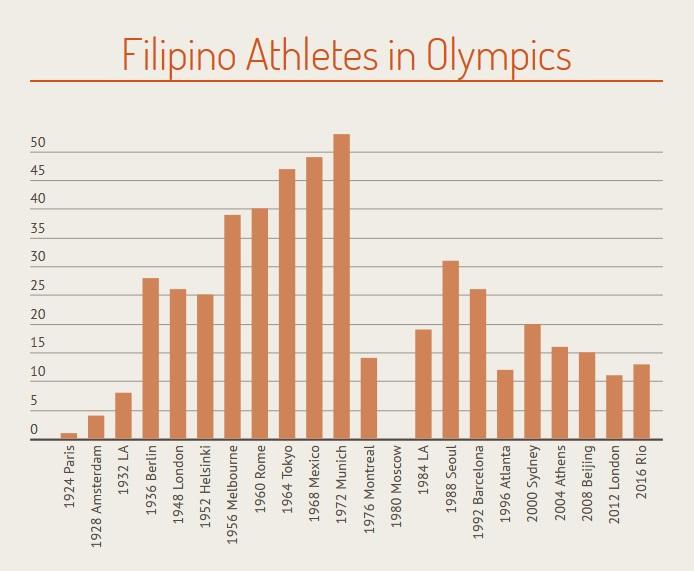
Thirteen Filipino athletes in eight sports competed in Rio this year, the sixth lowest number of delegates by the country overall and third lowest in the post-World War II era. But although it was way below the Philippines' average of nearly 30 athletes per edition of the Games, it was at least a slight improvement from the 11 athletes in London four years ago.
The country sent its biggest Olympic delegation in the 1972 Munich Games, where a 53-strong contingent represented the Philippines in 47 events. In the eight editions of the Games held from 1936 en route to Munich, the Philippines enjoyed its peak years in terms of number of Olympians with an average of 38 athletes per edition.
The next Games in Montreal in 1976, however, saw a big drop in the Philippine contingent with only 14 athletes participating in 21 events. After boycotting the following Olympics in Moscow, the country recovered and sent an average of 25 athletes over the next three editions.
But since the 1996 Atlanta Games, when Mansueto "Onyok" Velasco won the country's last medal prior to Diaz' victory in Rio, the country has never sent more than 20 athletes in the Olympics. The last four editions, in particular, saw the lowest number of athletes since the Philippines' first three appearances in the Games.
More women
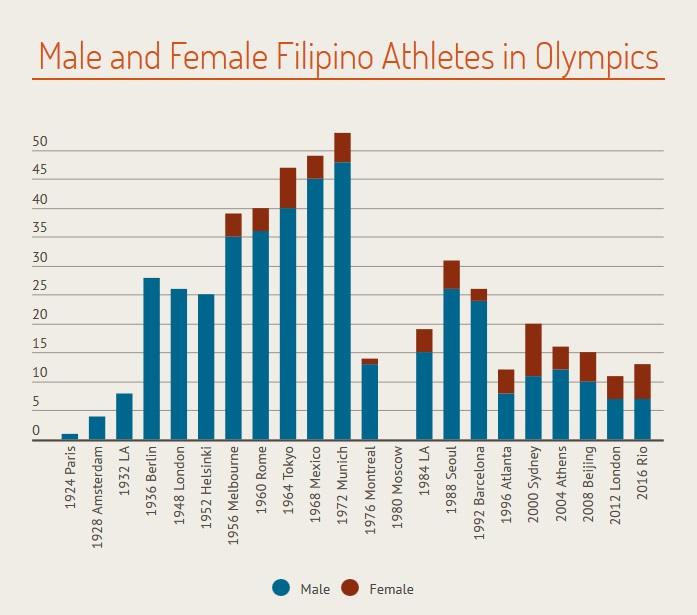
One upward trend of the Philippine delegation in the Olympics is the percentage of female athletes over the last six editions. Women, who only began competing for the country in the 1956 Melbourne Games, comprise about 13.1 percent of all Filipino Olympians since David Nepomuceno debuted in Paris nearly a century ago.
Until the Atlanta Games, women constituted less than a fourth of the Philippine contingent in the nine editions held since Melbourne. The lowest number of female athletes sent by the country was in 1976 in Montreal, when swimmer Nancy Deano was the sole representative of the fairer sex.
After the Barcelona Games in 1992, the percentage of female Olympians spiked as the number of overall Filipino athletes who competed in the Games fell from the country's glory years.
The highest number of women who represented the Philippines in the Olympics came in the 2000 Sydney Games, when nine female athletes or 45 percent of the 20-man delegation wore the country's colors.
But the six women in Rio by far is the highest percentage share of female athletes in any Philippine Olympic contingent since 1924. Accounting for 46.15 percent of the 13-man delegation, perhaps it is only fitting that the country produced its first female Olympic medalist this year.
After competing in the 58 kg division and failing to reach the podium in Beijing and London, Diaz went down to the 53 kg category in weightlifting. The decision paid off for the 25-year-old from Zamboanga, putting herself in the best position to achieve her goal of winning a medal.
In a stroke of luck, bronze turned into silver and Diaz became the latest sports heroine in the Philippines by becoming only the ninth Filipino to win a medal in the Olympics.
Her achievement becomes even more of a breakthrough in the context of the country's performance in Olympic weightlifting. Since women were allowed to participate in the sport starting in 2000, Diaz is so far the only Filipina weightlifter to compete in the Games.
Among the 15 individual weightlifters the Philippines sent to the Olympics to compete in 23 events since 1948, Diaz was the only woman and she was the first to go home with a medal on her third try.
Fewer boxers
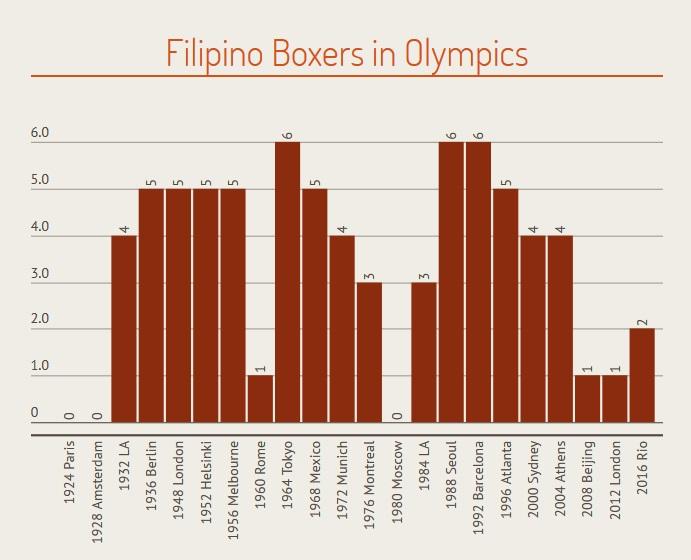
Nobody expected that the country's 10th medal in the Olympics would come from a sport as obscure to the casual sports fan as weightlifting. All eyes were on the two fighters in Rio - Charly Suarez and Rogen Ladon - because boxing is perceived to be the Philippines' strongest suit in the Games.
Unsurprisingly so, as the country won five of its medals or half of its total Olympic haul in boxing. In fact, the last four medals prior to Diaz' silver came from the sport - two silvers from Velasco in 1996 and Anthony Villanueva in 1964, and two bronzes from Roel Velasco in 1992 and Leopoldo Serantes in 1988.
Suarez and Ladon, however, could not replicate the feat of their predecessors after both lost their first matches in Rio.
Since 1932, 66 boxers fought for the Philippines in 75 events in the Olympics. The combat sport has the most number of Olympians for the country, even topping a team sport like basketball which has 63 athletes to see action in the Games.
Boxing sends an average of almost four athletes per edition, with Filipino fighters competing in 18 Games in a row after having none in 1924 and 1928. It is one of the only three sports which has never failed to produce a Filipino Olympian since 1932, along with athletics and swimming.
The other two sports account for the remaining four medals the Philippines won in the Olympics with two each.
Medal-rich sports
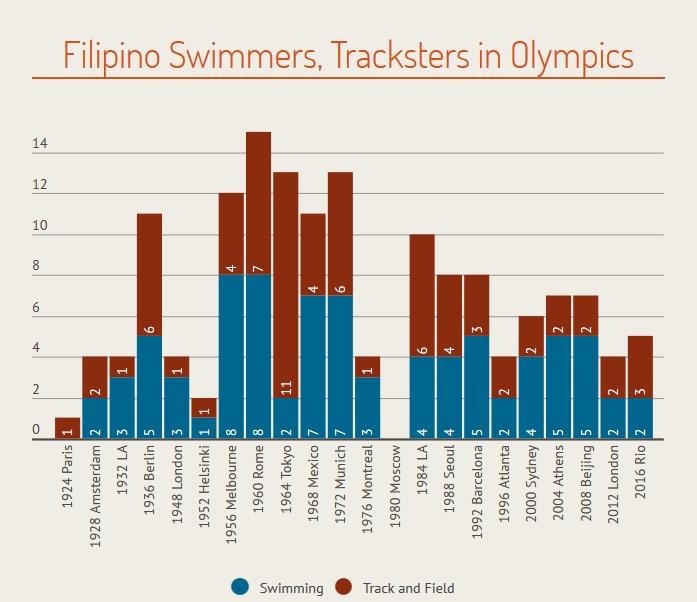
Athletics is the only sport which has sent an athlete in all 20 Olympic appearances of the Philippines, with 51 track and field athletes in 71 events in the Games. Its heydays arrived in the earlier editions, when Simeon Toribio and Miguel White claimed a bronze medal each for men's high jump and men's 400m hurdles in 1932 and 1936.
Swimmer Teofilo Yldefonso, meanwhile, is so far the only two-time Filipino Olympic medalist with back-to-back bronze medals in the men's 200m breastroke in 1928 and 1932. Swimming has sent 61 athletes in 82 events, making swimmers have the most appearances for the Philippines in the Games.
Both sports had their most number of Olympians in the 60s and early 70s, combining for 52 athletes in the four editions held during that period. Athletics had as many as 11; swimming had eight.
Athletics began to decline after the 1984 Los Angeles Games, while swimming was able to send five athletes in the Olympics as recently as 2008.
The pair of Jessie King Lacuna and Jasmine Alkhaldi, the new generation of Olympian swimmers for the Philippines, qualified to Rio under the universality rule of the sport. Both failed to advance in the 400m and 100m freestyle events.
Long jumper Marestella Torres-Sunang, hurdles specialist Eric Shauwn Cray, and marathoner Mary Joy Tabal all earned their spots via qualifying tournaments, but they all fell in the track and field events.
First-timers
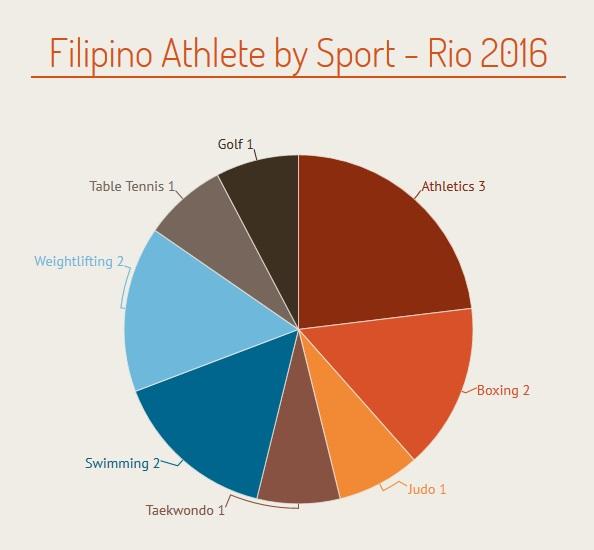
First time Olympians, meanwhile, could be seen as a silver lining as they made a pioneer Olympic appearance for their respective sports. Ian Lariba, who carried the flag in the opening ceremony, made history as the first Filipino to qualify for table tennis at the Games.
Golf returned to the Olympics for the first time since 1904, giving a chance to three Filipino golfers to showcase their wares among the best in the world. Only Miguel Tabuena answered the call of the flag, however, as Angelo Que and Dottie Ardina begged off due to concerns about the Zika virus.
Overall, the future of the Filipino athletes seems to have promise under the new government. President Rodrigo Duterte generously added P2 million on top of Hidilyn Diaz' mandated prize money of P5 million, while his appointee, Philippine Sports Commission Chairman William Ramirez vowed to try to augment the agency's budget.
Ramirez has indicated his intent to get the whole five percent of PSC's mandated share in the Philippine Amusement ang Gaming Corporation (PAGCOR)'s gross income. The Commission has been receiving only half of the amount or 2.5 percent over the last 12 years.
The national sports program could be looking at an annual budget of around P1.2 billion if PSC could get the mandated allocation, enjoying around a 33 percent increase in its current allotment.
Diaz, meanwhile, has already announced her plans to go for the gold medal in weightlifting in the 2020 Olympics in Tokyo. She still has a long way to go to catch up with the top contenders, but if all goes well, the Philippines could at least count on having another strong chance to get an Olympic medal four years from now. —JST, GMA News

Need a wellness break? Sign up for The Boost!
Stay up-to-date with the latest health and wellness reads.
Please enter a valid email address
Your email is safe with us





